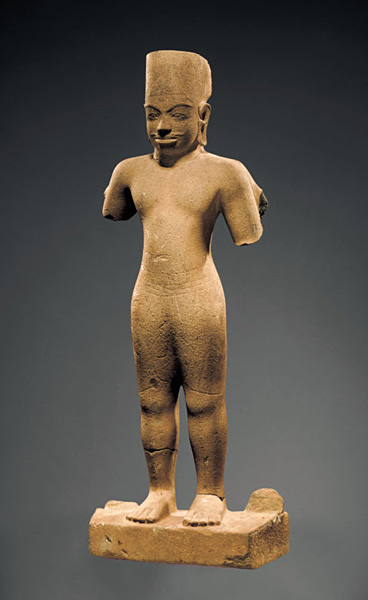|

Vishnu can be identified by his four arms and typical cylindrical shaped Kirita Mukuta. He is one of the principal gods of Hinduism and the embodiment of the quality of mercy and goodness, the self-existent all pervading power which preserves and maintains the universe and the cosmic order (dharma). To accomplish his task as protector, the popular god takes a number of incarnations which he sends to earth endowed with a spirit of self sacrifice and devotion. The doctrine of Vishnu's incarnations satisfied the great need of a population for a religion of faith in a personal god, a god sympathising with humanity and meeting it in its needs. In Cambodia his icon expressed the desire for a divine deliverer amidst the evils and miseries of life.
Depicted in a standing attitude Vishnu had originally four hands, each of them holding one attribute. The figure was attached to a supporting arch, part of which can still be traced on the back of the head and the base. Vishnu wears a short sampot (garment) arranged with finely engraved lines suggestive of the folds in the cloth and one of the extremities drawn between the legs and attached at the back. The garment tightly adheres to the body and is held in place by a scarf tied around the hips, supporting the sampot. Vishnu is portrayed with a moustache and wears a cylindrical cap (Kirita-Makuta) which descends very low on the neck and encircles the ears. The features of the god's face are precise and well executed: the eyes are outlined, nose is finely shaped and the curve of the lips establishes his authoritative expression.
Before the unification of the Khmer empire in the 9th century by Jayavarman II, the earliest religious sculptures of Cambodia are determined as the style of Pr�-Khmer or Pr�-Angkor. The figurative style is relatively naturalistic with well observed forms and carefully gentle volumes harmoniously flowing into each other. The arrangement of the sampot, the construction of the original arch and the shape of the cylindrical Kirita Makuta are typical characteristics of the Praset Andet and Prei Kmeng style. Other typical elements are the short ear lobes (in comparison with later Khmer sculpture), the round face with restrained smile, and the shape of the outlined eyes. The large lower lip shows similarities and reveals influence of Indian statues of the Gupta period. The treatment of the torso is less muscular than some earlier examples of the period and is related to traditions in the late 7th century or early 8th century. Similar stylistic comparisons can be made with a number of pieces, including two pieces in the Cleveland Museum of Art, see Sherman E. Lee, Ancient Cambodian Sculpture, nr. 6 and 7.
This early Cambodian temple sculpture is not only a depiction of a god with a powerful expression and a beautifully modelled body; it is created to achieve a spiritual effect, conveying a meaning beyond the sculpture itself. Not hampered by jewellery or rich ornamentations, the sensually carved deity comprises conceptional austerity with symmetrical components of pure volumes flowing harmoniously into each other, enhancing the intensity of the sculpture. The piece is among the rare examples of its period and exhibits the great artistic qualities of early Cambodian sculpture. The striking tension from all angles, and the virtually sensual and youthful presence of Vishnu make him to one of the important pr�-Angkor statues known in western collections.
Provenance: Private collection Denmark.
|

